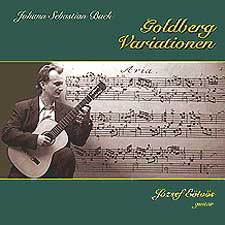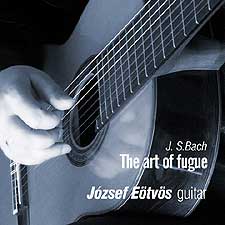![]()
![]()
![]()
![]()
József Eötvös - Transcriptions
of Bach, Brahms, and Chopin for Guitar.
J.S. Bach (transcribed by József
Eötvös) - Goldberg Variations, BWV 988. (62'48) CD EJ-01WZ.
Fryderyk Chopin (transcribed by József
Eötvös) - Vol. 1 (14 Pieces). (51'38) CD EJ-02WZ.
J.S. Bach (transcribed by József
Eötvös) - Lute Works 1. (67'34) CD EJ-03WZ.
Fryderyk Chopin (transcribed by József
Eötvös) - Vol. 2 (17 Pieces). (47'07) CD EJ-04WZ.
Johannes Brahms (transcribed by József
Eötvös) - 21 Hungarian Dances. (65'46) CD EJ-05WZ.
J.S. Bach (transcribed by József
Eötvös) - Die Kunst der Fugue (The Art of Fugue),
BWV 1080. CD EJ-06WZ.
József Eötvös, guitar on all
CDs. These recordings are self-produced and available through the performers
website:
http://www.spinnst.co.at/Gitarre/Eoetvoes/
 How
one feels about these recordings depends, in large part, on how one feels
about the art of transcription. A great deal of ink over the past few decades
has been spent extolling the sanctity of the composer's intention. Yet
many composers do not seem to be overly concerned about the intent of their
peers. Thus, Bach translates a Vivaldi violin concerto to harpsichord,
Mahler "touches up" the orchestration of Schumann's symphonies, and Schoenberg
rescores Mahler's
Das Lied von der Erde for a chamber ensemble.
Viewed a certain way,
all classical music performance is a transcription,
and a violation to some extent of the composer's intention.
How
one feels about these recordings depends, in large part, on how one feels
about the art of transcription. A great deal of ink over the past few decades
has been spent extolling the sanctity of the composer's intention. Yet
many composers do not seem to be overly concerned about the intent of their
peers. Thus, Bach translates a Vivaldi violin concerto to harpsichord,
Mahler "touches up" the orchestration of Schumann's symphonies, and Schoenberg
rescores Mahler's
Das Lied von der Erde for a chamber ensemble.
Viewed a certain way,
all classical music performance is a transcription,
and a violation to some extent of the composer's intention.
But what of transcription from one instrument to another? Here we are clearly moving outside the realm of the composer's intent. However, the results are best judged in practice, not in theory, and on these disks József Eötvös makes a compelling case for transcriptions as a means for discovering new aspects of familiar works. His Chopin disks are surprisingly effective: one quickly becomes adapted to the arppegiated legato of the guitar and is rewarded by hearing these well-known works in a more transparent setting than the concert grand. Of course, something of the music's density and richness is lost on the more restricted resources of the guitar as well as some of Chopin's rhythmic effects, but this in turn emphasizes other aspects of the music, especially melody.
If the disk of Brahms' Hungarian Dances is ultimately more satisfying, it may be because the work is less wedded to any specific instrumentation. Brahms himself scored them originally for two players at a single piano, then transcribed them for solo piano and later for orchestra. The pieces originally derived from melodies that Brahms heard played by "gypsy" orchestras in Vienna, hence there exists another layer of transcription. Basically a collection of folk and popular tunes, they translate well to almost any setting, including guitar. Eötvös's playing here is at its most charismatic, lively and confident, bringing a joyfulness to the music that is sometimes lacking in more traditional settings.
Less passionate but ultimately more involving is the recording of Bach's Goldberg Variations. This is in every way a remarkable performance, rivaling Julian Bream's CD of Granados and Albéniz as the finest guitar recording I've ever heard. From the opening notes of the Aria, Eötvös sustains Bach's argument perfectly, emphasizing the breadth and depth of the music. Despite what must be awesome technical difficulties, the guitar is in many ways the perfect instrument for this work. Clearer in texture than the modern piano, the guitar allows for a much greater range of expression than the rigid mechanism of the harpsichord. From the liner notes, I gather that this is not a note-for-note transcription, but, unlike the Chopin, there is no sense of compromise or simplification
If in transcribing the Goldberg Variations Eötvös has done the improbable, then his transcription and performance of the Art of the Fugue approaches the impossible. And it turns out that it is impossible, at least on a traditional guitar: Eötvös uses two 8-string guitars, differently tuned, and overdubbing (guitarists can get a sense of how the transcription is constructed by playing the CD Extra material at the end of the second disk, which contains recordings of the first voices of four pieces and sheet music for the second voices). The sameness of the guitars' timbre makes some of the fugues hard to follow at first; however, this disappears with familiarity and what emerges is a performance less monumental than most, more personal, more intimate, akin to the sublime isolation that pervades Glenn Gould's interpretations of Bach.
As noted above, these disks have limited distribution and can be obtained most easily by contacting the performer at the above address (they may be available through The Musical Offering in Berkeley).
